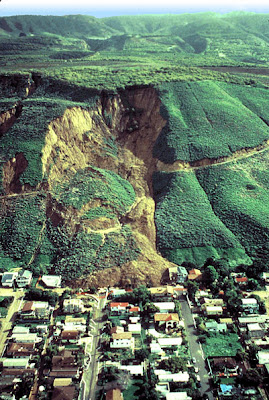Preamble
This page was brought to you by Raymond Angelo, Jolene Dong, hours of research, hours more of procrastination, and lots and lots of caffeine. We hope you, the masses, will enjoy this moving post.
"Mass" means "material". And "movement" means "the act, process or result of moving". Putting the two statements together, we realize that mass movement is materials in the act, process or result of moving. Whoa.
Dictionary.com definitions aside, mass movement is the downward movement of material on slopes under the influence of gravity. This happens in the form of landslides, mud slides and avalanches. In nature, mass movement occurs without hooha or furore, but as human populations and our occupation of the land increases, the effect of mass movement in our lives also increases.
We intrude into areas more prone to mass movement, and as we intrude, we may accelerate mass movement through our human activities...resulting in disasters, even fatialities.
1) Gravity
Gravity exerts itself on all places on Earth, and in most places, gravity is harmless, even helpful. However, when gravity's pull exerts itself on material on a slope, the pull occurs on two directions; downwards and in the direction of the slope. A resultant force results which may cause movement down the slope.
2) Water
Water is an instrument which reduces shear strength. It reduces the natural cohesiveness between grains, pushing the grains apart, reducing the friction between them.It also reduces friction, adds weight, dissolves the material, and reduce the internal strength of the mass.
Evidently, the role of water is large in mass movement.
3) Shear Strength and Shear Stress
Like good and evil, shear strength and stress (with good being strength being good and stress evil) have to be in a certain composition for there to be balance. The shear strength, which is the internal resistance of the body to movement, must exceed shear stress, which is the force causing movement of the body, for the mass to be stable.
In the event that shear stress>shear strength, like with good and evil, all hell will break loose. Or in this case, sediments, rocks, general geographical material will break loose.
There are many types of mass movement, such as flows, heaves and slides. However, the most rampant type of mass movement are landslides and this is brought about by the very unique climate of Singapore.
The climate of Singapore is humid and hot all year round, with temperature varying very little. The average rainfall which varies between 1600mm to 2500mm is said to be a large contributor to mass movement.
Areas prone to mass movement are Bukit Timah, Jurong, Bukit Batok and Fort Canning; all of which have high slope heights and steep slope angles.
In the past years, there have been hundreds of minor landslides, and a few major ones. Some of them are as follows:
Where: Bukit Batok
When: 1989
A cut slope at Bukit Batok Sports Complex failed after heavy rain. Continuous rainfall of three days brought about the slope failure.
Where: Jalan Dermawan
When: December 2006
The slope failure was brought about by heavy rainfall. Though no one was hurt, the area had been evacuated and was monitored for a period of time by Mindef.
Where: Bukit Batok
When: January 2007
Continuous heavy rainfall in
1) Companies are set-up to measure and ensure soil and slope stability. Soil Investigation Pte Ltd is a prime example.
2) The following processes are carried out regularly to ensure slope stability
- Site investigation; Provide soil investigation services to contractors and developers to ensure the safety of building sites.
- Soil laboratory testing; Measure and classify soil strength.
- Supply and Install Geotechnical equipment and monitoring
3) Set up Equipments and Instruments
-Inclinometers; to help monitor slopes and landslides to detect zones of movement.
-Tiltmeters; to monitor the stability of structure and give us early warning.
-Peizometers; to monitor pore water pressure to evaluate slope stability.
-Borehole Extensometer; to measure the movement and soil of rock along the axis of the borehole.
-Crack Monitoring; to monitor join movements and cracks in rocks or concrete.
Conclusion
In a land with very little of it, Singapore's slopes are especially prone to mass movement. As residents of this country, we should enrich ourselves with the relevant knowledge of mass movement our slopes are suspect to.
Is that it?
We have identified mitigations adapted by the government to handle mass movement. However, we ourselves can get involved, so do find out, explore and see what you can do for your nation's rocks. Don't just go with the flow and let things slide. Take matters into your own hands, and even if you heave and ho, at least you won't be letting your nation fall.
Blogger's PS: Ignore that last paragraph. I have no idea what I'm thinking.





